FM: 'We must learn the lessons' of WWIpublished at 16:48 GMT 11 November 2018
Nicola Sturgeon says Armistice is an opportunity to "express our gratitude but also to learn the lessons" of World War One.
Read MoreSunday marks 100 years since the end of World War One, on 11 November 1918
The Queen and senior royals attended London's Cenotaph for the national remembrance service
The Prince of Wales and the prime minister were among those laying wreaths - along with the German president
People's Parade saw 10,000 members of the public file past the Cenotaph
World leaders gathered in Paris, as commemorations took place across the Commonwealth
Services also took place across the UK - and about 1,000 beacons were lit
Sophie Morris, Jo Couzens, Alex Kleiderman, Jennifer Scott and Francesca Gillett
Nicola Sturgeon says Armistice is an opportunity to "express our gratitude but also to learn the lessons" of World War One.
Read More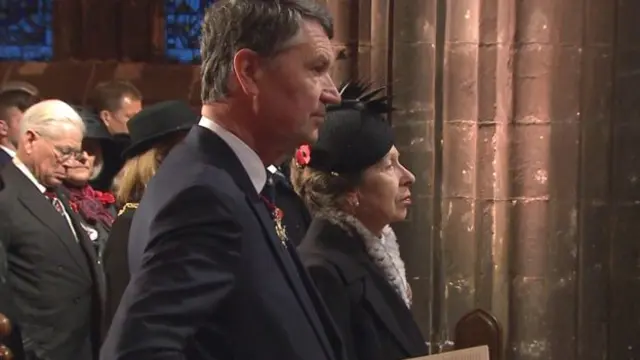 Image source, bbc
Image source, bbcThe Princess Royal attended a commemoration service at Glasgow Cathedral with her husband Sir Timothy Laurence
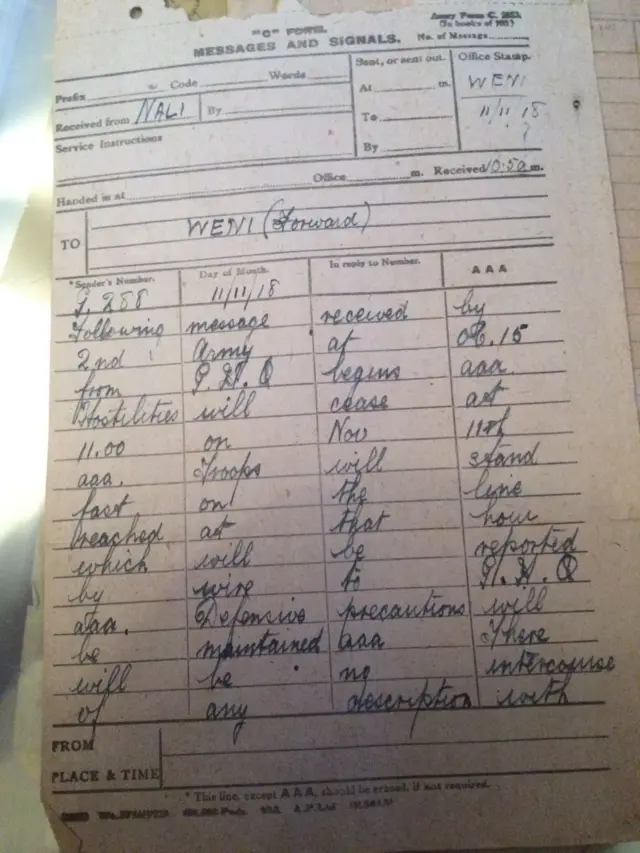 Image source, Eleanor de Bruin
Image source, Eleanor de BruinA telegram sent by a soldier in 1918 announcing the Armistice has been passed down as a family heirloom.
Ted Groves, a signal clerk serving on the Royal Artillery in Northern France, took down the message 100 years ago today.
It says "“Following message received by 2nd Army at ?:15 from G.H.Q begins. Hostilities will cease at 11.00 on Nov 11th. Troops will stand fast on the line breached at that hour which will be reported by wire to G.H.Q.
Defensive precautions will be maintained. There will be no intercourse of any description with the enemy until receipt of instructions from G.H.Q. Further instructions follow. Addressed all concerned.”
Ted's brother Robert sadly lost his life during the war.
His granddaughter Eleanor de Bruin, 34, has kept the telegram and hopes it continues to pass down through the family.

A commemorative ceremony is now taking place in St Anne's Cathedral in Belfast to remember the fallen.
The Duke of York arrived at 16:00 GMT to attend the service and gave a reading during the ceremony.
Northern Ireland Secretary Karen Bradley and Democratic Unionist MP Jeffrey Donaldson are also among guests at the service, during which poet Michael Longley is set to read his work Ceasefire.
The service in Belfast is taking place at the same time as ceremonies in Dublin, Glasgow and Cardiff, ahead of the service at Westminster Abbey this evening.
After nightfall, a beacon will be lit at a public event in the City Hall grounds at 19:00.
Watch now on iPlayer
 BBC iPlayer
BBC iPlayer
In the early 1960s, the BBC collaborated with the Imperial War Museum to create a landmark television series on the 50th anniversary of the outbreak of World War One.
Over 280 eyewitnesses were interviewed for the series, including veterans and civilians from Britain, France and Germany.
Quote MessageI think perhaps they'd reached the stage when they could talk about it.
Julia Cave on interviewing veterans and civilians for the 26-part 1964 BBC series The Great War
An insight into the mind of a soldier going 'Over the top'
A selection of the original interview recordings filmed for The Great War are available on iPlayer for the next year.
Also available is the documentary I Was There that pieces together some of most poignant moments of the interviews to reveal the human experience of the war.
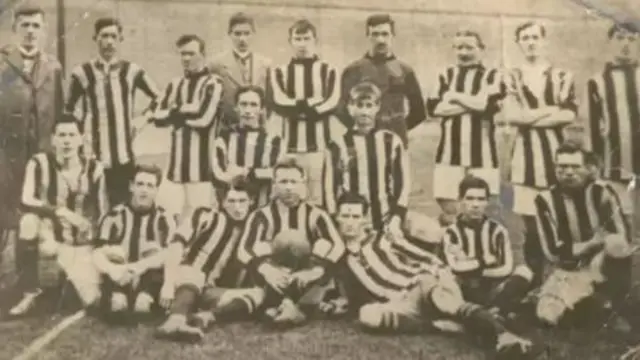 Image source, Ulster Council
Image source, Ulster CouncilWilliam Manning was part of the Antrim Gaelic football team that reached two All-Ireland finals.
But like so many young men of the time, the outbreak of World War One changed everything.
His sporting career was cut short, when in 1916 he enlisted in the Royal Dublin Fusiliers regiment of the British Army.
And after rising to the rank of Lance Sergeant, Manning was on front-line duty near St Quentin when the Germans launched an offensive in Spring 1918.
He was hit by a machine-gun bullet and killed instantly
 Image source, Ulster Council
Image source, Ulster CouncilResentment towards British rule was growing in Ireland, with rebels plotting an independent Irish Republic as Irish nationalism rose.
However with the Armistice Day centenary, the Gaelic Athletic Association (GAA) has made moves to express more acknowledgement for the significant role William Manning and many other of their former members played.
The GAA have been releasing a short online biography of 11 members who fought in the war during each of the 11 days approaching the Armistice Day centenary.
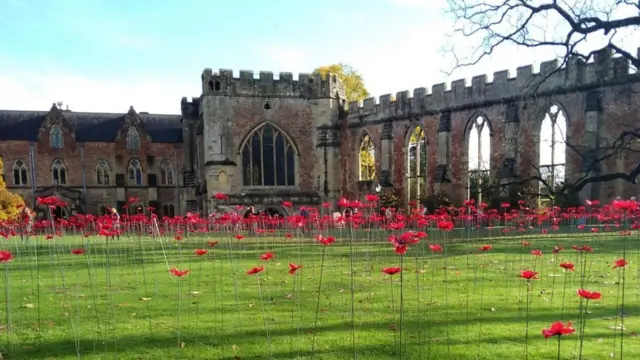 Image source, Bath and Wells diocese
Image source, Bath and Wells dioceseThe final Somerset Poppy has been planted at a special service at the Bishops Palace in Wells as part its Remembrance Day service today.
In total 7,986 poppies, one for each of the men and women from the county killed in WW1, form the poignant display in the palace gardens.
More than 4,500 local school children took part in the project to create the metal-stemmed flowers.
Dan Vidler from Coxley Primary School came up with the idea and the poppies have been planted there over the past two days.
He said: "It's overwhelming, it's a really powerful experience to see the end result of such a lot of work by the team who have helped to push the project forward."
About 100,000 poppies cascaded from the Anderton Boat Lift in Cheshire, known as the Cathedral of the Canals, in a tribute to the "forgotten" waterway men of World War One.
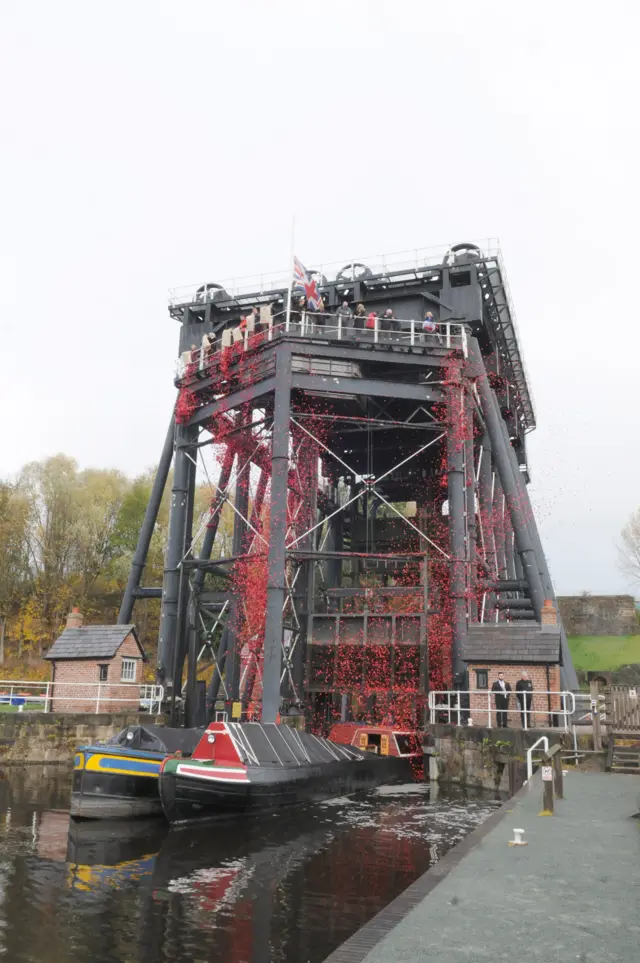 Image source, Canal River Trust
Image source, Canal River TrustAt the start of the conflict, the significance of their work - moving cargo up and down the country - made them exempt from fighting.
But by 1916, all unmarried boatmen under the age of 25 were eligible for call up.
Many went into the Royal Engineers where they were used as boatmen to ferry troops in Belgium and France.
Their skills were also in demand in Mesopotamia, in what is now Iraq, where they helped maintain water-based supply lines as well as being part of river attacks.
Her Godmother was queen Victoria...
Allow X content?
This article contains content provided by X. We ask for your permission before anything is loaded, as they may be using cookies and other technologies. You may want to read X’s cookie policy, external and privacy policy, external before accepting. To view this content choose ‘accept and continue’.
Sky News reporter tweets...
Allow X content?
This article contains content provided by X. We ask for your permission before anything is loaded, as they may be using cookies and other technologies. You may want to read X’s cookie policy, external and privacy policy, external before accepting. To view this content choose ‘accept and continue’.
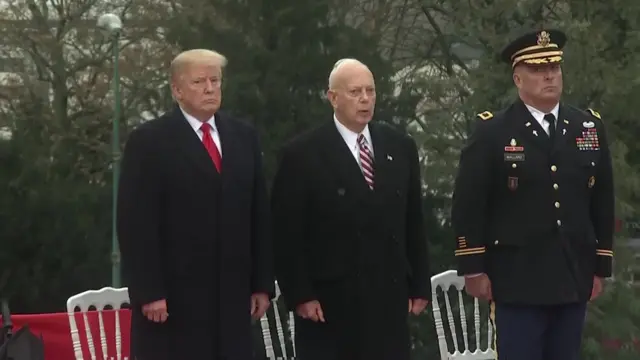 Image source, Reuters
Image source, ReutersPresident Trump is now attending a ceremony at the Suresnes American Cemetery in Paris.
The cemetery is the site where more than 1,500 US causalities are buried, as well as 20 unidentified World War One soldiers.
The cemetery's chapel also bears the names of 1,000 other Americans whose final resting places are unknown.
After both the French and US national anthems were played, President Trump addressed the crowd.
He paid tribute to the "brave Americans who shed their blood in this horrible, horrible war".
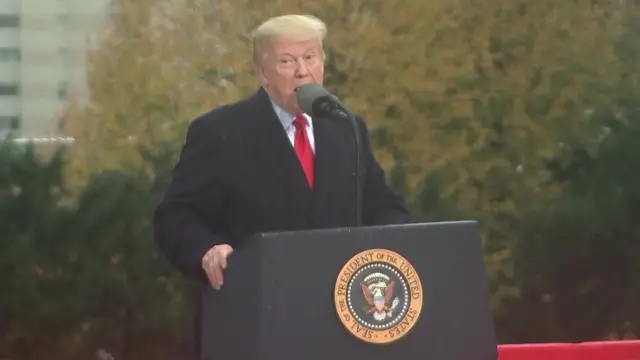 Image source, Reuters
Image source, ReutersHe says Armistice Day is "enshrined with Veterans' Day" in the US.
And referring to the fallen soldiers buried in the cemetery, he added: "America is forever in your debt."
Around 26,000 American soldiers lost their lives in World War One, which President Trump referred to as "America's deadliest battle in history".
"Our soldiers fought through hell and turned the tide of war, and each of these marble crosses marks the lives of an American warrior," he said.
President Trump presented a French Major General with an American flag to "memorialise our fallen heroes where they rest for all of eternity".
 Image source, PA
Image source, PANims Purja at the peak of Ama Dablam
A former Gurkha soldier has planted a poppy tribute at the peak of a Himalayan mountain to mark Armistice Day.
Nims Purja, 35, reached the peak of Ama Dablam in the eastern region of Nepal on Sunday.
He said he wanted to do something "very special" to mark the centenary.
"I feel very humble to be paying tribute to all those who gave their lives for our freedom today," he said.
Mr Purja was born in the Dhaulagiri region of Nepal and joined the Brigade of Gurkhas in 2003 before joining the Royal Marines.
Next year, he wants to raise over £1m for mindfulness charities by climbing all 14 of the 8,000m-plus Himalayan peaks in seven months.
 Image source, Reuters
Image source, ReutersIn moving services across Australia, huge crowds paid tribute to the servicemen and women who gave their lives in World War One.
Prime Minister Scott Morrison spoke of their ultimate sacrifice, describing scenes of devastation at Fromelles in northern France where bodies littered the battlefield.
More than 10,000 servicemen from the Australian and New Zealand Army Corps (ANZAC) died during the Gallipoli campaign on the Turkish peninsula.
In New Zealand, there was a 100-gun salute on the Wellington waterfront, while nationally people cheered, church bells rang and emergency services sounded their sirens.
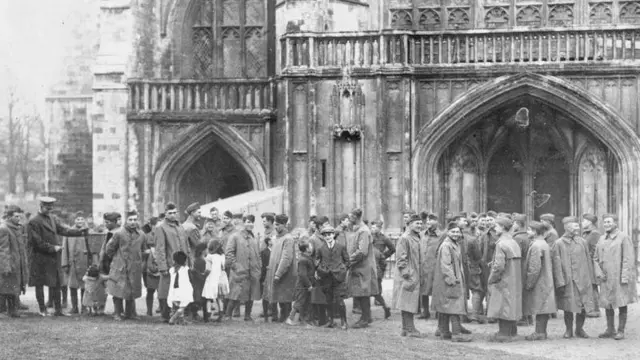 Image source, IWM
Image source, IWMUS soldiers queuing to enter Winchester Cathedral on 11 November 1918.
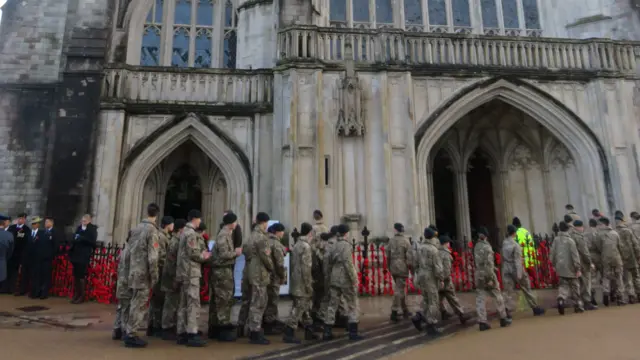 Image source, Winchester Cathedral
Image source, Winchester CathedralAnd exactly 100 years later, cadets queue to enter the cathedral for today’s service.
Nicholas Witchell
BBC royal correspondent
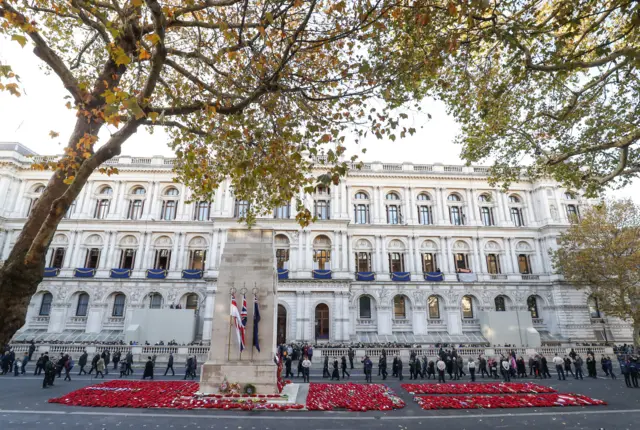 Image source, PA
Image source, PA“Simple, grave and beautiful“ - so wrote The Times newspaper in 1919 about the Cenotaph on Whitehall.
It was made of wood and plaster, and was intended only as a temporary saluting base for the great Peace March - marking the signing of the peace treaty in July 1919, which formalised the Armistice.
But so striking was the impact of the Cenotaph on the public that demand grew for it to become a permanent memorial to Britain’s war dead.
 Image source, PA
Image source, PAA colourised photo of the Cenotaph in 1920, the year it was constructed from Portland stone
The Cenotaph we see today, constructed from Portland stone, was unveiled by King George V on the second anniversary of Armistice Day, 11 November 1920.
In every peacetime year since, it has been the focal point for Britain’s national Ceremony of Remembrance for the dead of the two world wars and other conflicts.
Prince Edward and Sophie Countess of Wessex are attending Wales' national remembrance service at Llandaff Cathedral.
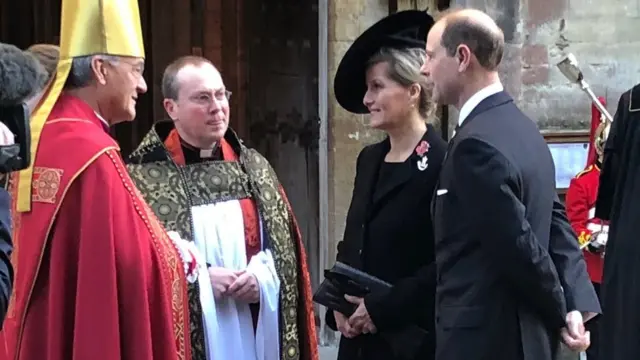
The Archbishop of Wales greets Prince Edward and Sophie Countess of Wessex
Nicola Sturgeon says Armistice Day is an opportunity to "express our gratitude but also to learn the lessons of that conflict".
Scotland's first minister was attending a ceremony in Edinburgh to mark the centenary of the end of World War One.
Nicola Sturgeon says we must 'learn the lessons' of WWI
Commemorations have taken place at the Cyprus Street memorial in Bethnal Green, east London, where a plaque lists the names of 26 men who died in World War One.
All had lived on the road.
It is thought the number of deaths represents the biggest loss of life from any one London street.
The memorial continues to be looked after by the residents of Cyprus Street.
Allow X content?
This article contains content provided by X. We ask for your permission before anything is loaded, as they may be using cookies and other technologies. You may want to read X’s cookie policy, external and privacy policy, external before accepting. To view this content choose ‘accept and continue’.
The US president tweets...
Allow X content?
This article contains content provided by X. We ask for your permission before anything is loaded, as they may be using cookies and other technologies. You may want to read X’s cookie policy, external and privacy policy, external before accepting. To view this content choose ‘accept and continue’.
As part of the "Pages of the Sea" project - organised by film director Danny Boyle - portraits of World War One soldiers have been drawn onto beaches across the UK.
The idea is that as high tide comes in and the portraits are washed away, there is a moment to say a collective goodbye.
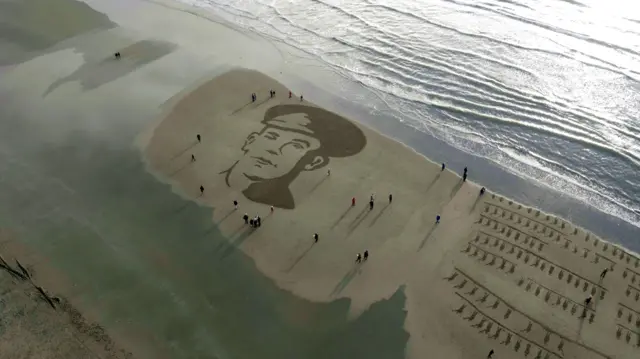 Image source, AFP/Pages of the Sea
Image source, AFP/Pages of the SeaAt Murlough Beach on the County Down coast, a portrait of local man John McCance who died at Passchendaele
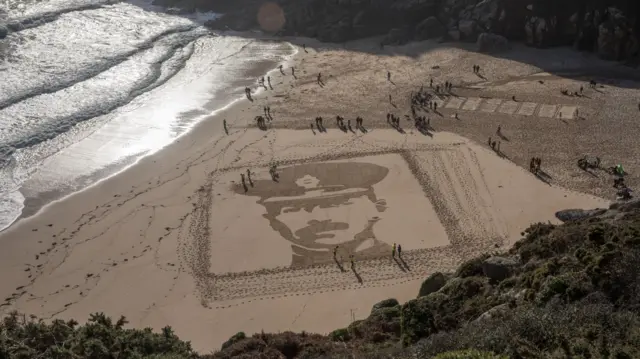 Image source, Getty Images
Image source, Getty ImagesA portrait of Lieutenant Richard Charles Graves-Sawle - who was killed by a sniper near Ypres aged 26 - was drawn onto the sand at Porthcurno beach in Cornwall
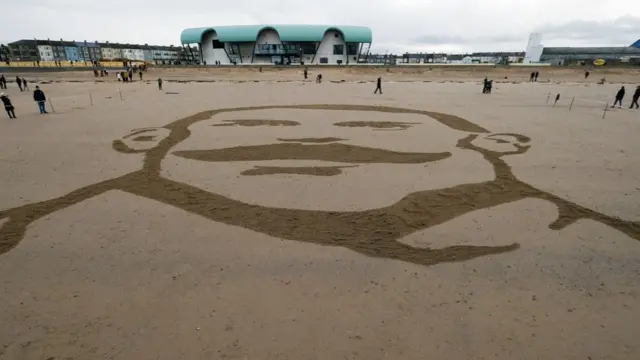 Image source, Getty Images
Image source, Getty ImagesThe image of Private Theophilus Jones, from Darlington - the first British soldier to die on English soil during WW1 - is created on Redcar beach
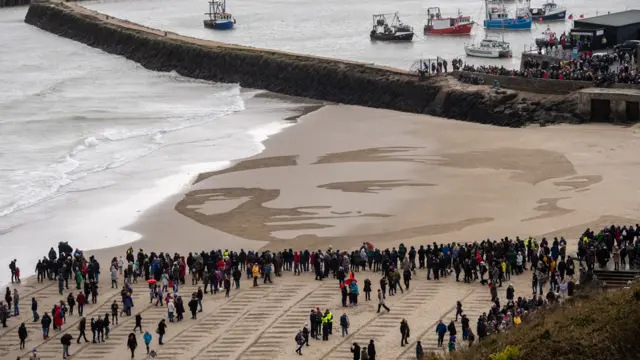 Image source, Getty Images
Image source, Getty ImagesOn Sunny Sands Beach in Folkestone, the tide begins to reach the face of war poet Wilfred Owen who was killed in the war
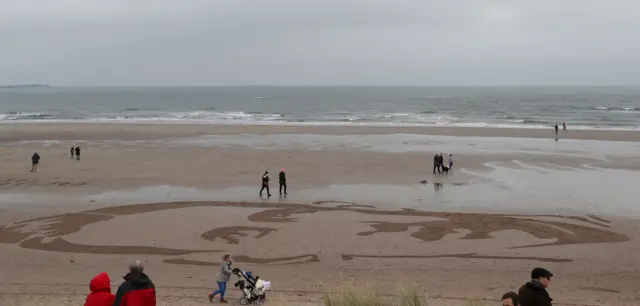 Image source, Reuters
Image source, ReutersThe beach at Seahouses in Northumberland was the canvas for a picture of William Jonas, a soldier killed in action
 Image source, Getty Images/Pages of the Sea
Image source, Getty Images/Pages of the SeaAlso at Folkestone, outlines of WW1 soldiers were drawn onto the sand